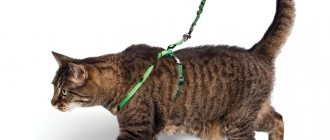Many cat owners want to go for walks with their tailed friends, but are afraid of the dangers they might encounter. I, as the author of this blog, a felinologist and the owner of a cat and a Scottish cat, as well as a dog, advocate walking with animals. But I'm not trying to convince those who don't want to walk their cats that they need to change their minds. This approach also has its place and I don’t see anything extremely bad in it. This blog is for those who want to walk with a cat, but are afraid after hearing enough horror stories. Below I will explain why I am for walking, what difficulties you may encounter and how to overcome them.
Outdoor dangers for cats
I'll start with the horror stories that, in fact, prompted me to write this blog. Recently, in one of the professional felinological groups, I came across an absolutely, in my opinion, crazy post about why walking is contraindicated for cats. The arguments were given such that hearing this from the lips of a colleague was scary and strange. Each of these arguments could be smashed to smithereens with even minimal knowledge. I will give the highlights below.
Article continues after advertisement
Of course, we cannot turn a blind eye to the dangers that await cats on the street. You'd have to be a fool to deny their existence. However, my motto in this regard is: prepare, take action, and then relax and have fun.
Which pets are not recommended for walking?
There are animals that are prohibited from being taken outside. For such cats and their owners, walking can become a big problem.
It is not recommended to walk animals in the following cases:
- Kittens up to 5 months. They have a very weak immune system, and on the street you can catch a virus or accidentally get injured.
- Impressionable, aggressive, timid animals. They pose a danger to others. A sudden movement or cry leads to aggressive actions by the animal. The cat may attack the owner or a stranger, get scared or run away.
- During heat, cats gather all the cats near them. If pet owners do not need such problems, it is not advisable to walk their pet at this time.
- Without a flea collar or vaccinations, your cat may become infected with something and pick up insects. Treatment is not cheap, so it is not worth the risk.
- Walking is not recommended for a long-term pregnant cat. If your pet has never walked outside, you should not go there during this period.
- Sick animals who have recently been ill or have undergone surgery need to stay at home.
Cars and people
Many people are afraid to let cats outside because... there they may be hurt by other animals, people, or run over by cars. And they are right to be afraid. Therefore, there can be no talk of free-ranging without an owner.
Moreover, you can only walk your cat on a leash. Even if you are nearby, the animal may be frightened by some sudden sound or another animal and begin to run wherever its eyes look. Therefore, a leash is required.
It is better to walk with a cat in uncrowded places. And if you see that a dog has appeared somewhere, take the cat in your arms. Although there are cats that are not at all afraid of dogs.
A separate problem is intrusive passers-by. Such people, when they see a domestic cat on a walk, immediately strive to come up and touch it. And children also try to do this without asking. Each owner decides for himself whether to allow this or not. Personally, I don’t allow it, because... my cat doesn't like hugs, and anyway, it's my cat. If they want to cuddle cats, let them have their own. But for most people, the fact that a cat doesn’t like hugs is not an argument - they still climb, because the cat’s opinion is of little interest to them. Therefore, immediately say that she bites and scratches. This is usually sobering.
What's the result?
Walking your cat is not necessary, but it can be very helpful. Especially if you have a pet from active breeds, for example, a Bengal or an Abyssinian. For active and inquisitive cats, walks will help them expend energy, satisfy their curiosity and gain new experiences.
If you are thinking about walking your pet regularly, first make sure that he is really interested in it. If a cat is afraid of the street and shows no interest at all in the world outside the apartment, you should not force it to walk. And vice versa, if your pet is actively interested in the street and often sits near the door, he will enjoy walks.
To start walking your cat:
- buy a harness and leash,
- stock up on treats and patience,
- accustom your cat to a harness and leash,
- start with short walks in quiet places,
- Gradually increase the distance and duration of walks.
Infections
One of the arguments against walking cats in the article I mentioned above was the fact that outdoors a cat can encounter fungi, in particular Histoplasma capsulatum. It is a soil fungus that forms mycelium in the environment and transforms into a yeast form in the host. Infection occurs through inhalation of dust.
Sounds scary. But a smart owner, when told such horror stories, will definitely make inquiries and find out that this fungus can infect not only animals, but also people. Therefore, logically, everyone, not just cats, needs to stay at home to be afraid of it. But we are not sitting. So why should cats?
In addition, this kind of fungi is part of the world around us and affects only weakened mammals. You encounter these and other fungi literally everywhere, but have any of you or anyone you know gotten sick? Such cases are rare. And all because our immune system does not sleep: for a healthy body, such fungi, like most bacteria, are nonsense. Even the fungi that cause ringworm are mainly dangerous only for children and small kittens: adult animals and people easily crush these fungi with their immunity.
Article continues after advertisement
But the factor of dangerous infections is worth taking into account and you need to prepare for it. However, it is not fungi that need to be feared most of all, but primarily panleukopenia (distemper), calicivirus infection and rabies. These are, indeed, dangerous infections, and therefore domestic cats that do not have vaccinations do not need to walk outside. In addition, they should not have contact with other animals that do not live in your family.
Unvaccinated pets have every chance of getting sick, even while at home. The same plague virus can be brought home on shoes along with particles of dirt. In general, vaccinations are needed in any case.
In addition, even if a vaccinated cat is currently weakened, for example, she has recently been ill with something, is pregnant or nursing kittens, and is also in heat, there is no need to take her outside yet.
Petersburg woman with a cat on a leash, explain: why walk the animal, he’s scared!
Why walk a domestic cat, what scares him more: dogs or noise on the street, why does the animal need a leash, and are such walks really good for the cat? Maine Coon owner Anastasia Kovaleva explains how and why she walks her pet in St. Petersburg.
Photo from the archive of Anastasia Kovaleva
When did you start walking your cat?
My husband and I have wanted to have a pet for a long time. At first we thought about a dog, but since we study and work, there would be no time left for such a pet. Then they decided to get a cat - a more independent animal.
My husband jokingly suggested getting a “cat with a dog’s character.” And this joke went on so long that we actually adopted a Maine Coon - a wild domesticated cat, which already, at seven months old, can be compared in size to an average dog.
We decided that the wild cat needed wild nature, so we started taking her outside from the first months. At first, Alpha (that’s the cat’s name) was very afraid of street noises: she pressed herself to the ground and crawled to a secluded place. We are still teaching her to take such walks.
Why are you walking your cat in the city?
We live in St. Petersburg, that’s why we walk with her here.
Because of the always bad weather, Alpha and I don’t go for walks much. I don’t want to take her outside where there is slush, rain, frost and wind. We walk mostly in warm weather. It’s also possible to go out in winter, since Maine Coons are adapted to the cold, but she doesn’t particularly like the snow.
Now we are vacationing in Crimea. When they brought Alpha to the sea, she didn’t really like it either. According to the veterinarian and our observations, she is absolutely comfortable walking only in the forest.
Photo from the archive of Anastasia Kovaleva
How do passers-by and other animals react to a cat with a leash?
When we decided to walk Alpha on the street, we told our relatives and friends about it. Everyone reacted to this absolutely normally, because they understood: the cat is big and needs to move a lot. They knew that we consulted the veterinarian on everything.
Only passers-by were surprised. People still come up and ask why all this. Some people say they tried walking their cats but it didn't work out. Very often we are asked if this is really a Maine Coon.
Alpha herself is not very fond of passers-by and dogs. When she first met the Labrador, she automatically rose on her hind legs, her eyes bulged, and her fur stood on end. The dog got scared and left. She tries to avoid passers-by.
Five myths about walking cats on a leash
1.
Walking cats is harmful
We consulted with a veterinarian and found that walking cats can only be dangerous if it causes them stress. And Maine Coons, they are wild, they need it: more space outside, fresh air. Now Alpha goes outside on her own and explores the territory.
2.
Maine Coons are dangerous for children and small dogs
I have never encountered a Maine Coon harming anyone. Our Alpha, if she doesn’t like something, just takes it and leaves; she is peaceful, loving.
3.
You can also cuddle a cat outside
Alphas don't really like strangers. When someone approaches her that she doesn't know, she feels threatened. These are the situations that can cause her stress.
4.
You can walk your cat anywhere
I think it's different for each cat. Again, the main thing is not to let her experience stress. Now we have come to the conclusion that we do not take Alpha out into the courtyards, but only walk with her in parks and forests.
5.
A cat doesn't need a leash
Of course, you need a leash. A cat, like any other animal, can run away if it gets scared of something.
What challenges are you facing?
The only problem is the noise on the street. The cat becomes uncomfortable, this is unusual for her. Something might scare her on the street, and after that she will cower and lose her appetite. It works like a human: in such situations she needs to run away to a secluded place.
Wild mice
If the cat is not free-ranging, but follows you on a leash and, moreover, sits in your arms, there is no point in worrying that it will eat a mouse, rat or bird: you simply will not allow it. And you will do the right thing, because... wild rodents can be infected with rabies and other infections.
Yes, most cats that have free access to the outdoors are alive and well, despite eating mice and birds. But it’s still better to be careful. If you want to feed your cat mice, you can buy special laboratory mice for it.
Fleas and ticks
Fleas and ticks are a real threat worth talking about. Even cats sitting at home sometimes need protection from them, because, again, flea eggs can be brought home on shoes. Another thing is that completely domestic cats need minimal protection, and often they can do without it.
Those who go outside, as well as cats living in the same house with dogs, need protection in 100% of cases. These can be special collars, sprays, drops on the withers and even tablets.
A cat that walks decorously with you on a leash, and does not run around basements and neighboring yards alone, will have enough of one means of protection. If for some reason the cat is free-range (which felinologists and veterinarians do not approve of), he will need a combination of two means of protection, for example, a collar and drops on the withers or a spray.
In addition to the fact that you will apply protection to your cat, I recommend choosing places where there are fewer ticks during tick activity. For example, we have three main places for a walk: a square with lawns and sakura trees, a forest park and a field behind the forest park. We have never seen ticks in the park, so we walk there calmly. There are ticks in the forest park, but we have never caught them there, so we consider the park a place of moderate danger. But during tick season we try to walk there carefully. And we don’t go out into the field at all, since we are guaranteed to catch someone there. Explore places nearby and find the best ones!
How to put on a harness
There are different types of harnesses, but cats prefer the “H” and “8” models.
Option “H” is a pair of rings fastened with a strap (sometimes with two straps to provide greater protection, the second strap is attached from below parallel to the first). The “latch” of the larger ring is located immediately behind the front paws, the smaller ring is secured around the neck. The strap, connecting the rings along the back, does not allow them to “spread”.
The main difference between the second model, which has the shape of an infinity or a figure eight, from the first is the method of fixing the rings - the rings are connected directly to each other without the help of a strap.
There is only one “lock” on this model, and many owners find it difficult to put the harness on their cat. And you need to act without wisdom:
- open the lock;
- hang the first ring on your pet’s neck;
- place a hanging strap around the chest behind the front paws;
- close the “latch”.
Both models have proven themselves well, but mustaches react more calmly to the harnesses of the “H” option. Most likely, this is due to the fact that the cross strap prevents the ring from squeezing the throat too much.
Worms and poison
Anything that can get into a cat's mouth on the street is potentially dangerous. Worms are found in the soil and grass, but you shouldn’t be particularly afraid of them. We constantly bring worm eggs home on our shoes, so the cat is already familiar with them in any case. If you carry out periodic deworming, then there is no need to worry.
Article continues after advertisement
But the food scattered on the ground, poisoned by dog hunters, is worth attention. Never allow your cat to take food from the ground! If a dog can be trained not to do this, then with cats the problem is easier to solve with the help of a leash and your attention.
Stress
All cats experience negative experiences on their first walks. This is fine. If you sat inside four walls all your life and didn’t know that there was a world around you, you would be scared too. In addition, cats have a heightened sense of hearing and smell, and therefore new sounds and smells of the street seem stronger to them than to us, which is also frightening and stressful at first. But over time, everything changes - and the cat, who hated the street, suddenly begins to love it, because he understands: it’s interesting, it smells nice, it gives new vivid impressions.
With the right approach, which starts with taking the cat in a carrier or in a special space backpack out into the yard for 5 minutes, almost any animal can be taught to love walks. To do this you will need from 1 to 10 outputs. But there always remains a small percentage of those who are against it, even despite regular appearances. It’s probably better to leave them at home and not force them: if the animal experiences negative stress every time during a walk, this will not bring anything good - then let it breathe the air while sitting on the windowsill.
Walking rules
In order for a walk with a cat to go properly and not discourage the animal from going out into the fresh air, you must adhere to the following recommendations:
- Avoid noisy places. Any loud sound of a passing car or a child's scream can greatly frighten your pet, and therefore it is undesirable to walk on the street near the roadway or playground. It is better to carry your pet in your arms or in a carrier to the nearest park or any quiet place.
- Avoid contact with strangers. It is better not to allow stray animals near your pet to avoid fights or to avoid infection.
- The cat's safety comes first. When an unfamiliar and, in addition, aggressive dog runs towards you, it is not recommended to keep the cat on a leash. It is better to pick him up in your arms or give him the opportunity to climb the nearest tree. This way the purr will feel safe and will not be stressed.
- It's better to eat at home. It is important to ensure that the cat does not pick up food in its mouth on the street to avoid infection or poisoning.











